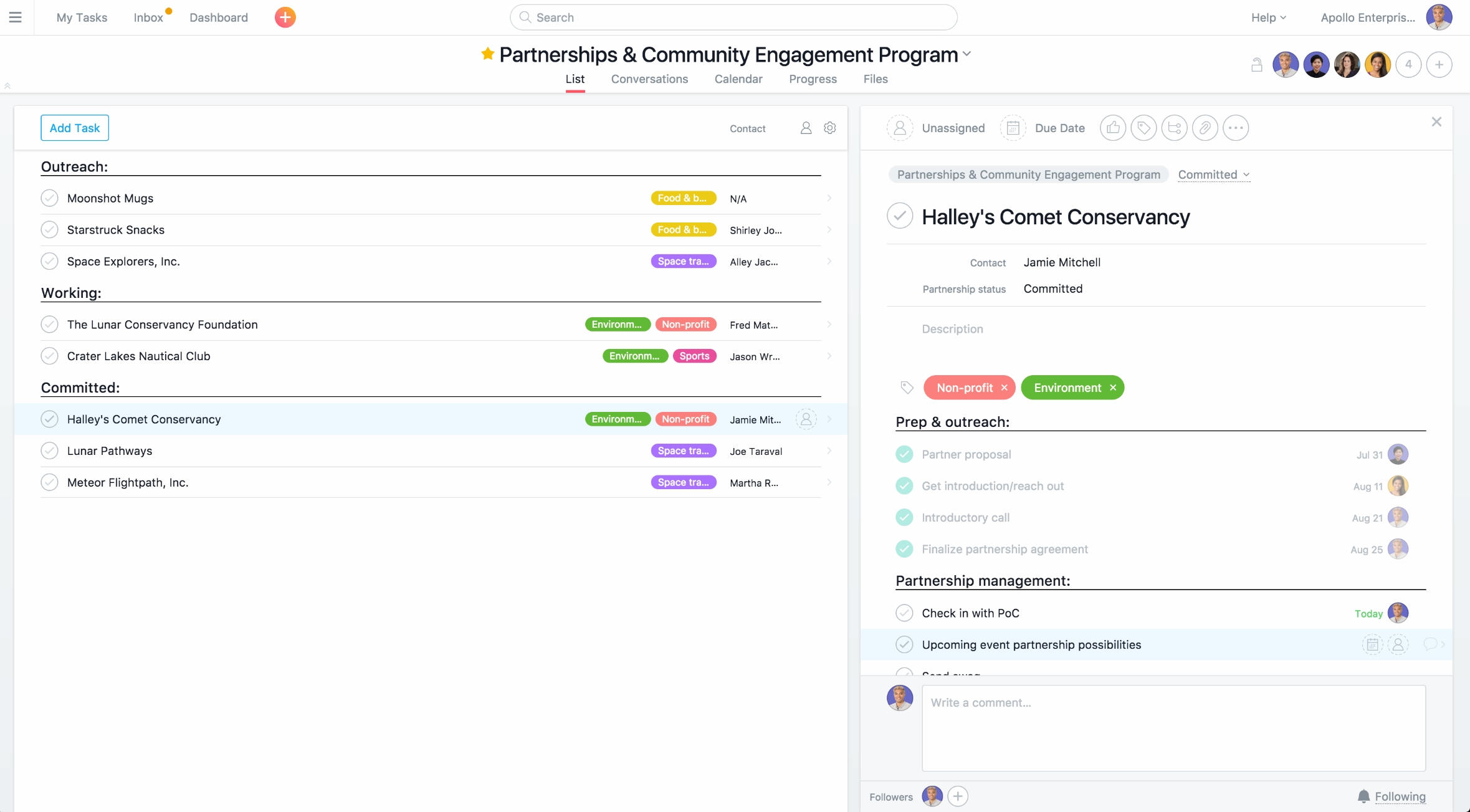Ale in a day’s work: How Fort Point Beer Co. builds successful partnerships and engages the community #withAsana

Nestled in an old army motor pool building on Crissy Field in the Golden Gate National Recreation Area is Fort Point Beer Company. A craft brewery dedicated to brewing balanced, approachable beers, they’ve taken the Bay Area by storm in recent years. But unlike many craft breweries that have cropped up over the past decade, Fort Point has taken a deliberate approach to every aspect of their business, especially their role in the community they call home. We spoke to Casey Sasser, their Head of Partnerships and Community Engagement, to learn about their program and its success.
“We’re so fortunate to be a local business in San Francisco,” says Casey. “But we don’t want to just be a local business—we want to be an active member of the community, too.” Going beyond selling popular brews is a key component to their business and success. By giving back to the community and putting themselves out there in ways other breweries might not, they’ve set themselves apart and strengthened their brand—one chilled beer at a time.
Partnerships aren’t just nice to have, they’re a way for companies to build brand awareness and be active participants in their local communities. Beyond the good feelings they provide for employees and the brand awareness they build, partnerships are an important tool for growing a business.
For Fort Point, what started out as an organic partnership with nearby groups like the Golden Gate National Parks Conservancy has grown into a fully-staffed program that works with hundreds of partners annually. We took a look at how they established and grew their Partnerships and Community Engagement program, the challenges they faced with scaling, and how tracking their work along the way has contributed to their business success. Here are a few things we thought you could learn from them.

Reflecting your brand values
There are two core components to Fort Point’s brand and business: approachability and innovation. “Incorporating our company values in our community and partnerships program has been fundamental to its success,” says Casey. They focus on approachability by working with smaller, grassroots organizations like schools and community groups. And in a nod to innovation, they partner with larger, cutting-edge organizations like the SF Film Society and The Exploratorium.
By partnering with organizations who share your values, you’ll reach a broader audience who also shares those values and advance causes that are meaningful to you and your team, too.
Identifying meaningful partners
In building their partnerships program, Fort Point identified three main areas to focus on when selecting partners: art and film, the environment, and food (specifically, sustainability and food access). Each of these areas resonates with a different part of their brand:
- Art and film: They’re committed to being design-oriented.
- The environment: They work with groups dedicated to conserving the space where they work.
- Food: As part of the bar and restaurant industry, they’re committed to supporting a sustainable food system.
Identifying more concrete areas that map to your values is a great way to find partners. And once you’ve identified who you want to work with, know that at the beginning, chances are you’ll be doing more outreach than receiving inbound requests for partnerships.
In Casey’s experience, one of the more rewarding parts of her job has been seeing the program grow from predominantly outbound messages to inbound interest. “Our program started out with us reaching out to partners, but now it’s flipped. People reach out to us, because they know this is something we do a lot and it’s a key part of our brand. It’s been really great to see that change.”
Providing value for both sides
Partnerships are only valuable if they’re serving both parties, which is a big part of how Casey thinks about their program. She focuses on working with people who are not just aligned with their values and interests, but take an interest in Fort Point’s work as well.
Another way she provides value is by evolving partnerships over time. No valuable partnership is a one-and-done thing—Casey recommends staying engaged with the work each of your partners is doing, and chances are they’ll do the same.
Tracking your efforts
Building partnerships means managing many relationships at once, which makes tracking your work essential to the success of your program. Partnerships are relationships, which require nurturing, communication, and trust to succeed—things that can’t be provided if your team is overwhelmed or constantly wondering who’s doing what, by when, and why.
As Fort Point scaled their Partnerships and Community Engagement program, they were faced with more and more relationships to track. While this means more chances to engage with the community, it also represents more opportunities for work to fall through the cracks. Casey and her team recognize the value of tracking every partnership—from strategy to on-the-ground execution—in order for their program to be a success.
“Whether I’m tracking charitable donations or upcoming events, there are always lots of different pieces on the go at once. That’s why I need to be sure we’re in sync with our partners every step of the way.”
“Whether I’m tracking charitable donations or upcoming events, there are always lots of different pieces on the go at once. That’s why I need to be sure we’re in sync with our partners every step of the way.”
To stay on top of everything, Casey relies on Asana. She tracks where partners are in the process, as well as what actions are needed from her and her team to deliver on partnership commitments. She organizes her partner pipeline by stage—outreach, responded, and committed—and tags each partner by type—art and film, environment, or food. With this system, she can get a bird’s eye view of the overall health of her program any point in time.

Partnerships also involve a lot of action items beyond overall strategy, whether you’re working with partners on content, events, donations, or more. It’s important to track the smaller details and day-to-day deliverables so that you can provide a high-touch experience for your partners.
For example, since Fort Point’s partnerships often take the shape of beer donations, Casey tracks upcoming events and donation pickups in Asana. She’s able to loop in all relevant team members—whether they’re attending an event, delivering beer, or responsible for a brewery pickup that’s scheduled. Casey also tracks donations and partnerships year over year to show the growth of her program and its impact on the business.
Measuring success for your business and the community
“Evaluating partnerships might be the trickiest part to them,” says Casey. “It’s easy to measure how much beer is made, sold or donated, or even the number of attendees at an event, but it’s difficult to measure the impact of partnering with an organization.” As with any kind of brand marketing, quantifying results can be difficult, but that’s why Casey focuses on qualitative measures of success, like brand perception, comments from attendees, and renewed or increased inbound interest in partnerships.
One measure of success that Casey looks at is how rewarding partnerships are for her team and the whole Fort Point organization. “I love what we do because we get to be part of amazing things that different organizations are doing for the community,” she says. While you can’t always put a number value on partnerships, they can drive engagement and satisfaction across your team and community.
“I love what we do because we get to be part of amazing things that different organizations are doing for the community”
As Fort Point has proven, it’s so important to provide partners with the best experience possible. After all, just like customers, partners often turn into your best advocates. But growing a partnerships program involves many moving pieces to track, which is why it’s crucial to have clarity on the 30,000-foot view and everyday deliverables.
By using Asana to track every part of their partnerships program, Casey can focus on the best part of her job: “Through our partnerships, I get to connect directly with the community about Fort Point. We’re able to guide them and share our craft—all while connecting over great beer.”
Learn how teams like Fort Point use Asana to do great things together.
Photos by Molly DeCoudreaux

